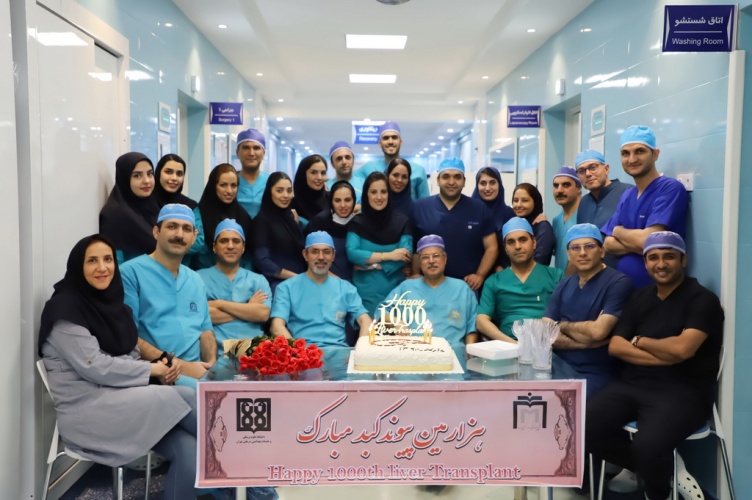The 1000th Liver Transplant Surgery at the TUMS’ Affiliated Hospitals

Professor Ali Jafarian, Head of the Liver Transplantation Unit of Imam Khomeini Hospital Complex and TUMS ex-chancellor, stated in an interview on October 5th, 2019, and provided some information about liver transplant and its history in Iran. Read all about this magnificent achievement here:
Can you tell us about the history of the liver transplant in Iran?
Prof. Ali Jafarian: “The first Iranian liver transplant in Iran was carried out in 1993 in Shiraz city. After that, due to lack of infrastructure and legal issues, a limited number of transplants were performed until 2001. This process has accelerated since the law on brain death in Iran was adopted in 2000, and Imam Khomeini Hospital and a transplant center in Shiraz were the pioneers of liver transplant in Iran. The first liver transplant was performed at Imam Khomeini Hospital in January 2001 for a 12-year-old girl who is now almost 30 years old and is married and has a good life. The number of liver transplants has increased since 2006, and now we have more than 800 liver transplants in Iran. There is a large transplant center in Shiraz which was ranked first in the world in 2017 in terms of the number of transplants per center. Imam Khomeini Hospital is the second in the country and the first in Tehran. In terms of the number of liver transplant operations, Iran is ahead of other countries in West Asia and North Africa.”
Please tell us about the transplants at TUMS centers?
Prof. Ali Jafarian: “At TUMS, we officially started transplantation in 2001 and have been accelerating since 2006 and have been on the rise ever since. In 2018, we had 176 liver transplants at Imam Khomeini Hospital, and since2016, we have started pediatric liver transplants and simultaneous liver and pancreas transplantation. So far, we have had 31 pediatric transplants and 13 cases of simultaneous pancreatic and kidney transplants. We are also prepared for simultaneous liver and heart transplantation.”
What contributed to the successes of the liver transplant center of Imam Khomeini Hospital Complex?
Prof. Ali Jafarian: “The University’s Liver Transplant team has several prominent features; the group consists of 100 strong, well-coordinated and self-sacrificing members. In this team, we have more than 20 faculty members from all disciplines in medical fields. One of our most important achievements is that the team has been working steadily for the past 18 years. When it comes to liver transplants, well, 1,000 is a very important number, indicating that there is a great deal of capacity in Imam Khomeini Hospital Complex, and there are capable people who can do it. We currently accept every patient under any circumstances. The team is now able to treat critically ill patients with acute liver failure and those who have had previous surgeries.”
What are the liver transplant features?
Prof. Ali Jafarian: “Patients who are critically in need of a liver transplantation have a shorter lifespan. If they have acute liver failure, the life span may be as short as one to two days. Chronic patients, who come on our waitlist generally have a life expectancy of less than a year. Patients who need liver transplants have a very difficult life. The families of these patients are also heavily involved and family life is disrupted. Technically, the operation is very complex and difficult, especially in patients with a history of previous surgery! The average time for liver transplant surgery is now four and a half hours at Imam Hospital, and sometimes it can take seven to eight hours in complicated cases. During the first month after surgery, very important events can occur, such as bleeding, infection, and transplanted organ dysfunction. The first month is sometimes very stormy, and then the patient gradually returns to normal life, and the amount and dose of the medication decreases over time.”
Do you have any advice to prevent liver diseases?
Prof. Ali Jafarian: “The most common cause of liver transplants is fatty liver and this is a serious alarm. Currently, the first problem or cause is not hepatitis, but fatty liver. Twenty-five percent of these 1,000 liver transplantees have had a fatty liver, and this is very alarming. The most important thing is that fatty liver is a lifestyle issue, we need to be careful about obesity, inactivity and poor diet so that a large population in the future will not be added to the liver transplant list. People who are overweight or have underlying diseases such as diabetes, high blood fat and high blood pressure are advised to have an ultrasound and liver tests to determine if they have fatty liver. If someone finds out that he/she has fatty liver and take care of it, the course of the disease will stop. If you modify your diet and lose weight, the fatty liver usually returns to normal or does not get worse; otherwise, the fatty liver enters the inflammatory phase, at which the enzymes rise, and the ultimate fate is irreversible liver cirrhosis.”
How long is the waitlist for a liver transplant?
Prof. Ali Jafarian: “The high priority patients usually wait less than three months.”
Can you tell us one of your memories in the liver transplant center?
Prof. Ali Jafarian: “Our best memory is when the patients with acute liver failure who are in a coma come round the day after the liver transplant and start talking to us.”
We wish Prof. Jafarian and his whole team more success and achievements in their valued work.

Your Comment :